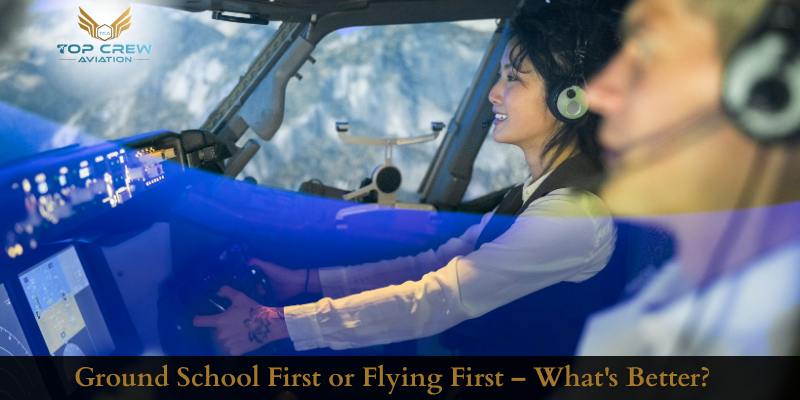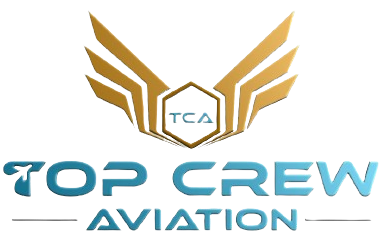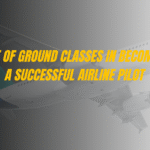
Are you confused about whether to begin your aviation journey with ground school or take flying lessons first? This is one of the most common questions aspiring pilots in India face. Understanding the right path is crucial for your success in aviation.
In this detailed blog, we’ll explore both options – ground school first vs. flying first – and help you make the best decision based on DGCA requirements, aviation industry standards, and student experience. This guide uses topics like DGCA ground school, pilot training in India, CPL exam preparation, and more to help you find clarity.
What Is Ground School in Pilot Training?
Ground school is the theoretical foundation of your aviation training. It involves classroom-based learning covering essential subjects required by the Directorate General of Civil Aviation (DGCA) in India.
Subjects Covered in Ground School:
- Air Regulations
- Aviation Meteorology
- Air Navigation
- Technical General
- Technical Specific
- Radio Telephony (RTR)
These subjects are mandatory for clearing DGCA exams before obtaining a Commercial Pilot License (CPL).
Duration:
- Usually 3 to 6 months (full-time)
- Some institutes offer part-time/weekend batches for students or working professionals
Ground school training is conducted in DGCA-approved ground schools or aviation academies in India.
What Is Flying Training?
Flying training involves actual flight hours under the supervision of a Certified Flight Instructor (CFI). It teaches you practical skills to operate an aircraft.
Key Components:
- Takeoff and landing techniques
- Navigation and flight planning
- Emergency handling
- Instrument flying
According to DGCA, a student pilot must log a minimum of 200 flying hours for a CPL.
Flying Can Be Done:
- After passing the DGCA ground exams
- Or in parallel with ground school (depending on the institute and student readiness)
Ground School First: Why It’s Recommended
Starting with ground school before flying is highly recommended for aspiring pilots in India. It builds a solid foundation for your aviation journey.
- Strong Theoretical Foundation:
Aviation is not just about flying—it’s a technical profession. Ground school teaches you essential topics like meteorology, air regulations, navigation, and aircraft systems. Without this knowledge, understanding what’s happening in the cockpit can be difficult and even risky.
- Essential for DGCA Exams:
To become a commercial pilot in India, you must pass DGCA theory exams. Subjects like Air Navigation and Meteorology require dedicated study. Starting with ground school gives you the time and focus needed to succeed in these exams.
- Cost-Effective:
Flight training is costly. If you start flying without clearing your theory papers, your flying progress can be delayed. You may need to repeat flying hours, increasing your total expenses.
- Structured Learning Path:
Understanding systems and theory before hands-on training leads to better comprehension, confidence, and memory retention during flight sessions.
- Self-Assessment Opportunity:
Ground school also gives you time to evaluate your interest and ability in aviation before investing heavily in flying.
In short, ground school first is the smarter and safer approach for future pilots.
Flying First: Why Some Students Choose It
While starting with ground school is usually recommended, some students choose to begin their training with flying. This approach provides immediate hands-on experience and can be very exciting for beginners.
Why Students Prefer Flying First:
- Instant Motivation:
Being in the cockpit from day one can boost enthusiasm and reinforce the dream of becoming a pilot. The thrill of flying often motivates students to stay committed.
- Quick Start:
Some students are unaware of the DGCA requirements and opt for flying because it feels like faster progress. Additionally, certain flying clubs permit students to begin logging hours before completing ground school.
Challenges of Flying Before Ground School:
- Lack of Understanding:
Without theoretical knowledge, students often struggle to grasp what’s happening during flight. This can slow learning and reduce confidence.
- Wasted Flight Hours:
Flying without understanding topics like radio communication or navigation may lead to repeating lessons, increasing both time and cost.
- Exam Pressure:
Without a strong theory base, passing DGCA exams later becomes more difficult. Many students feel overwhelmed catching up.
Ground School First vs Flying First: Comparison Table
| Feature | Ground School First | Flying First |
| Theory Knowledge | Strong | Weak initially |
| Cost Management | Efficient | Risk of wastage |
| DGCA Exam Preparation | Easy to manage | Difficult later |
| Learning Curve | Smooth transition | May feel overwhelming |
| Safety | Improved awareness | Less knowledge early on |
| Time Efficiency | Predictable path | Prone to delays |
| Confidence | Builds steadily | May struggle initially |
What Does DGCA Recommend?
The DGCA (Directorate General of Civil Aviation) does not have a fixed rule about whether you should start with ground school or flying first. But most flying schools approved by DGCA in India suggest beginning with ground school.
Ground school helps you learn the basics of aviation like navigation, weather, and air rules. This knowledge makes flying much easier and safer later.
You are allowed to do flying and ground school at the same time, but it can be stressful. Managing both theory and flying lessons together may become difficult.
Most students who finish their DGCA written exams before starting flying feel more confident and save money. They also face fewer delays during their flight training.
So even though it’s not a rule, doing ground school first is a smarter and safer choice for most student pilots in India.
What Should You Do? Expert Advice
If you want to become a pilot, here’s a simple and smart plan to follow:
- Start with Ground School: First, join a DGCA-approved ground school in India. Focus on learning key subjects like Air Navigation, Meteorology, and Technical General. These subjects are the base of your aviation knowledge.
- Clear the DGCA Exams: Prepare well for the DGCA written exams. Use mock tests, question banks, and revision classes to improve your chances. Clearing these exams early will make your training smoother.
- Begin Flying After Theory: Once you understand the theory, start your flying training. You’ll find it easier and more enjoyable because you already know the basics.
- Choose the Right Institute: Pick a training school that offers both ground and flight training under one roof. Make sure the school is DGCA-approved and has good instructors, aircraft, and facilities.
This step-by-step approach saves time, money, and stress.
Student Experiences: What Real Trainees Say
“I started with flying, but soon realized I was wasting hours because I didn’t understand what was happening. I paused and did ground school, and things became clearer.”
“Ground school helped me crack DGCA exams on the first attempt. When I started flying, I already knew aircraft systems, so I wasn’t nervous.”
Conclusion
If your dream is to become a successful pilot in India, the smartest and safest way is to start with ground school. This means learning all the important theory first — like weather (meteorology), navigation, air regulations, and how aircraft systems work.
The best path is:
Ground School First → Clear DGCA Exams → Start Flying Training
This order helps you save both time and money. If you start flying without passing your DGCA theory papers, you might face delays or even have to repeat flying hours, which can be very costly.
Ground school also gives you more confidence and knowledge. When you know what you’re doing in the air, flying becomes more enjoyable and less stressful. You’ll also perform better during your flight lessons.
Many flying schools and aviation experts in India recommend this method because it creates a solid foundation for your pilot training journey.
So, don’t rush into the cockpit. Take time to build your base with proper theoretical training. It will make your flying experience smoother, safer, and more successful.
Start smart, study first, fly later — that’s the best way to become a pilot.
Suggestion URL
Frequently Asked Questions
No FAQs found.



